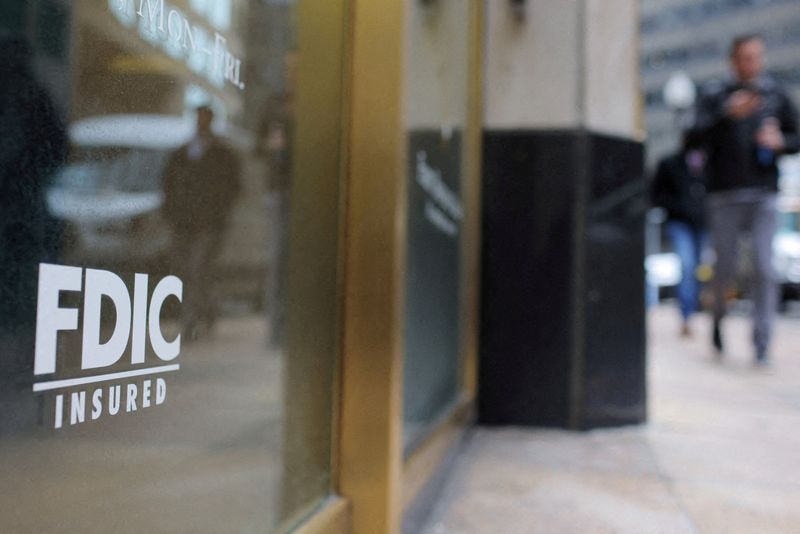By Hannah Lang and Pete Schroeder
(Reuters) - In the United States and many other countries, the government guarantees a certain amount of each customer’s deposits in the event of a bank failure, to protect both consumers and the broader financial system.
With the collapse of Silicon Valley Bank and Signature Bank (NASDAQ:SBNY) and the U.S. government backstopping all deposits at those firms, here is the state of play of deposit insurance in the United States:
WHAT IS THE U.S DEPOSIT INSURANCE LIMIT?
Currently, the Federal Deposit Insurance Corp (FDIC)guarantees deposits of up to $250,000 per person, per bank. That limit was enshrined in law by the 2010 Dodd-Frank reform law passed following the 2008 financial crisis.
That means, for example, that a married couple sharing a savings account would be guaranteed for up to $500,000 in deposits. It also means that $1 million in savings can be insured if the cash is spread across four different accounts at four different banks. Accounts the FDIC guarantees includes checking and savings accounts, as well as money market accounts and certificates of deposit.
Customer deposits at federally insured credit unions are also protected up to at least $250,000 per individual depositor through the National Credit Union Share Insurance Fund, which is administered by the National Credit Union Administration.
WHOSE DEPOSITS ARE NOT INSURED?
Generally speaking, accounts exceeding the $250,000 limit mostly belong to entities that need a lot of cash on hand to make payroll such as small businesses, nonprofits or municipal governments.
Many other investments, such as stocks, annuities or mutual funds, are not protected from losses.
More than $9.2 trillion of U.S. bank deposits were uninsured at the end of last year, accounting for more than 40% of all deposits, according to U.S. central bank data.
WHAT HAPPENED WITH DEPOSITORS AT SILICON VALLEY BANK AND SIGNATURE BANK?
The collapse of SVB on March 10 - the largest bank failure since 2008 - sparked concerns over whether small-business clients would be able to pay their staff if the FDIC only protected deposits of up to $250,000.
Some 89% of SVB's $175 billion in deposits were uninsured as of the end of 2022, according to the FDIC.
On March 12, U.S. regulators including the FDIC announced that they would make all SVB and Signature Bank depositors whole, even those whose accounts exceeded $250,000, through a "systemic risk exception" designed to prevent broader contagion to the U.S. banking system. Any losses to the FDIC's deposit insurance fund will be recovered by a special assessment on banks, the FDIC said.
Treasury Secretary Janet Yellen denied that the emergency actions meant that a blanket government guarantee now existed for all deposits, and said during a congressional hearing that any future failure would need to pose risks similar to those seen at SVB and Signature to qualify for the exception.
In a speech to bankers on Tuesday, Yellen said that the U.S. banking system was stabilizing and steps taken to guarantee deposits in those institutions showed a "resolute commitment" to ensure depositors' savings and banks remain safe. She also clarified that the government could similarly backstop smaller institutions if they too posed contagion risks.
WHAT IF I HAVE MORE THAN $250,000 IN MY BANK ACCOUNT?
While individuals are at risk of losing their money above the deposit insurance limit if a bank fails, the FDIC frequently arranges the sale of an ailing lender to a peer institution, which would then take over all the deposits. If a sale isn’t possible, the FDIC winds the bank down and pays out on the insured deposits. The process typically takes 90 days. Account holders can then can try to recover any uninsured deposits from the failed bank’s liquidated assets.
WHAT ARE THE RISKS OF UNINSURED DEPOSITS FOR BANKS?
For banks, a high amount of uninsured deposits pose their own risks. FDIC research from 2018 shows that account holders with uninsured funds are more sensitive to bad news and more quickly move funds to protect them. That means when a bank is in trouble, it may see money heading out the door when it needs it most.
Generally speaking, regulators do not discourage banks from taking in uninsured deposits, so long as they manage that liquidity risk.
COULD THE GOVERNMENT RAISE THE DEPOSIT INSURANCE LIMIT?
Some U.S. lawmakers have said Congress should consider whether a higher federal insurance limit on bank deposits was needed in the wake of the collapse of SVB and Signature Bank.
Senator Elizabeth Warren, a Democrat, and Senator Mike Rounds, a Republican, have questioned whether the $250,000 deposit insurance limit is still appropriate.

But increasing that limit would require legislation, which could face an uphill battle in a divided Congress heading into an election year.
Government officials have discussed the idea of increasing deposit insurance without obtaining approval from Congress as they brainstormed various approaches to solving the turmoil in banking, according to a Reuters report. However, that idea was not universally supported and is not seen as necessary by some officials.